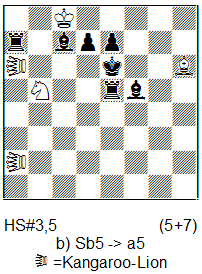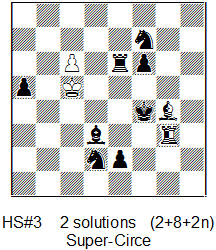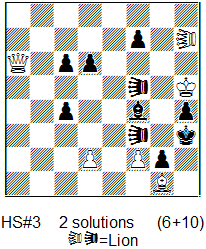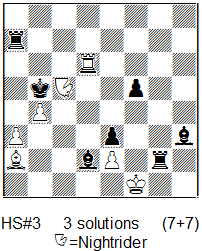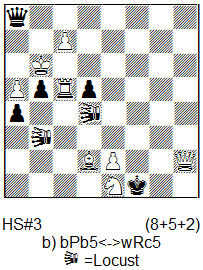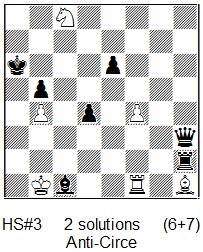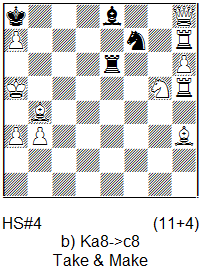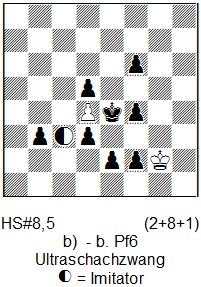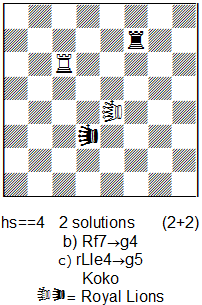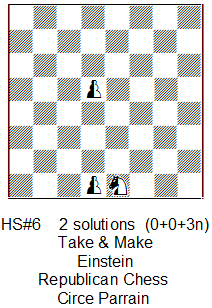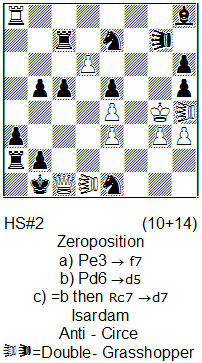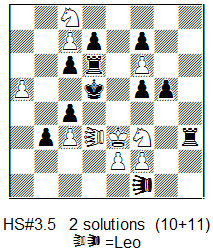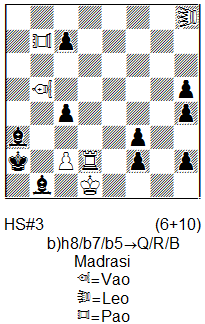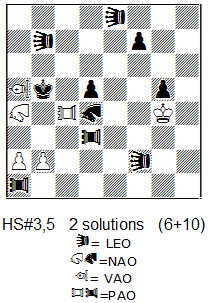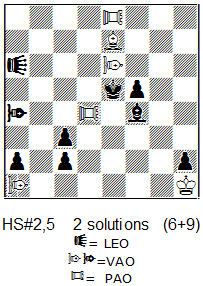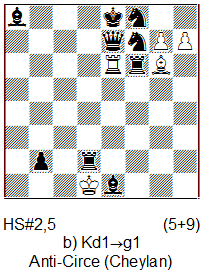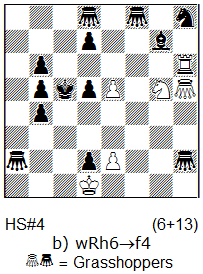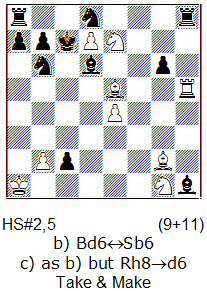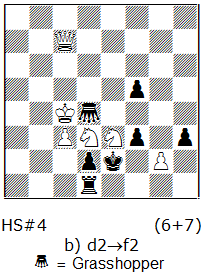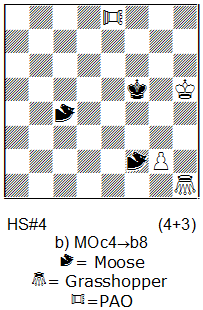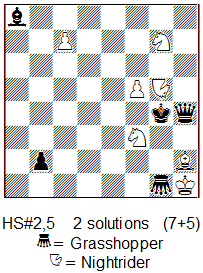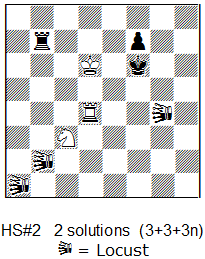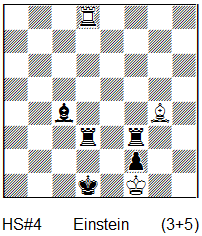
First of all I’d like to mention that I’m very satisfied about the extremely high level of submitted problems! 64 problems from 39 authors from 20 countries participated in the competition.
Most prominent fairy composers of the world participated and their works will certainly enrich and adorn the most modern genre in contemporary composition – Help-self problems!
Due to this excellent level of competition I have awarded many prizes. Also, it is a great success of the new site “Julia’s Fairies” and I want to congratulate the editor Julia Vysotska for her activity and for her talent as organizer of such a spectacular tournament!
The theme of the competition – play of fairy batteries (or anti-batteries) in Help-self problems, was attractive to many authors. The presented problems are dominated by compositions with rich strategic play, but there are also some very fine echo-compositions.
My main criteria for the awarding was the content of the problem, presented in a precise and economical form. In my opinion, in the Help-selfmate genre heavy constructions (for example – with 20 or more pieces on the board) are not desirable, although they are inevitable in some tasks.
Regarding material, I think that the most important aesthetical requirement is the use of all white and black pieces in all phases (solutions) of the problem. Of course, this is an ideal that cannot always be achieved. But if a white or black piece (not Pawn!) is superfluous in a phase of the problem, it must be perceived as a weakness. For each particular case the judge must consider how much this fault detracts from the problem.
An unaesthetic formation of twins can also be rated as a weakness – often such character has the so called “0 position”, and two or more changes in the formation of twins is also not pleasant.
In conclusion I want to point out that in making this award I was extremely frustrated by the differences between computer programs. Nowadays, very often when checking a problem with different programs (for example: Popeye, WinChloe, Alybadix) different results are received. This very difficult and important question has not yet been officially solved by the International Federation for Chess Composition. In this award, for every problem I can only mention the program used for testing.
IGM PETKO A.PETKOV
International judge of FIDE
——— PRIZES ———
|
Georgy Evseev & Lev Grolman
|
Sven Trommler
|
Vlaicu Crişan
|
1st Prize – Georgy Evseev & Lev Grolman – The best problem in this tournament – without any doubt! Critical moves of NAh5 and LEf1 are caused by interesting sacrifices of black Q and R. This paradoxical overture prepares a demonstration of the “Chinese-Indian theme” – creation of anti-batteries after LEf7/NAf6 and NAb2/LEd3. Black corresponds with the same type of combination realized by the NAc8, NAd7 and the black King. A very fine motive in this unique synthesis, where three duos of figures change their functions during the play (LEf1-NAh5; Qf8-Rd2; NAc8-NAd7) is the Umnov theme presented by the white King and black NAOs. Another good thematic fragment is the play of the indirect black King/Bishop battery. The only small negative point is the not quite equivalent play of the black NAOs between phases. I.1…Qf7 2.LExf7 NAf2 3.Kc8 NAf3 4.NAf6+ Ke4#; II. 1…Rb2 2.NAxb2 NAg1 3.Kd7 NAe4 4.LEd3+ Kf3#. (Py 4.61)
2nd Prize – Sven Trommler – An excellent Meredith, which demonstrates a very seldom and difficult combination in the black play: transformation of a black half-battery, which is created from the pieces Ke6, Pd7, Bf5! The white part of the content is an elegant and non-standard creation of reciprocal anti-batteries and batteries, where the exotic pieces Kangaroo-Lions show their true beauty. a) 1…Kf7 2.Sa3 Re6 3.Sc4+ d5 4.Sd6+ Rxd6#; b) 1…Kf6 2.Sc4 e6 3.Sb6+ d6 4.Sd5+ exd5#. (Py 4.61)
3rd Prize – Vlaicu Crişan – The problem demonstrates extremely dynamic play in which the specific effects of the “atomic condition” Super-Circe are of a record number – 5 half-moves from 6 possible in every solution! This concept is certainly very difficult for realization, though here are used the “crowning Super-Circe pieces” – nR and nB, which are well known as main actors in similar opuses from current practice. Pay attention to the play of three thematic duos of pieces: nRg3 & nBg4 (active): Active direct check vs. double passive annihilation; Re6 & Bd3 (active): Rear vs. front piece of black battery; Sd2 & Sf7 (passive): Guard of flight vs. block.
I.1.nRxd3[+bBg5] Ke5 2.nBxe6[+bRh5] Kxe6[+nBe3]+3.nRxe3[+nBc8]++ Bxe3[+nRd7]#; II. 1.nBxe6[+bRf2] Ke4 2.nRxd3[+bBg1] Kxd3[+nRf5]+ 3.nBxf5 [+nRa3]++ Rxf5 [+nBb3/nBc3]#. (Py 4.61)
|
Michel Caillaud
|
Kostas Prentos & Vlaicu Crişan
|
Mario Parrinello
|
4th Prize – Michel Caillaud – A very interesting formation of black anti-batteries: Gf3 and Gf5 change their places and roles in both solutions! Because the Umnov theme with figures of one color is impossible, I do not use that term here about the content. But this is a small terminological detail. The white play here is also good – creation of white Lion/Queen batteries with thematic tries 1.Qa3 and 1.Qc8. Unfortunately, the white Bishop on g1 is a full static actor in this wonderful spectacle, but without this piece the technical realization seems impossible. 1.LId3+ LIh1 2.Qa3 LId1 3.LId7+ LIf3# (1.Qa3?); 1.LId7+ LIf8 2.Qc8 LIc5 3.LId3+ LIf5# (1.Qc8?). (Py 4.61)
5th Prize – Kostas Prentos & Vlaicu Crişan – The cyclical battery creation between R,B,N is an eternal theme in fairy genres, where this trio is very actively exploited against the backdrop of most modern fairy conditions. In this problem we see some nice new moments: a surprising perfect and economical interpretation, combined with fine black distant blocks on c7,a3, c3, and three mates by the black battery. I. 1.Rg6 Rc7 2.Be6 Kc6 3.Bc4+ Rxg6#; II. 1.Ng7 Rxa3 2.Re6 Ka4 3.Rb6+ Rxg7#; III. 1.Bg8 Bc3 2.Ne6 Kc4 3.Nc7+ Rxg8#. (Py 4.61)
6th Prize – Mario Parrinello – A beautiful idea – the initial battery Rc5/nLOd4 deteriorates and a tour by the neutral Locust (the rear battery-piece) results in the formation of a totally new battery – Se1/nLOd1. The mating move is a return of the neutral Locust to its initial position – Switchback, because in this moment the initial forward battery-piece (the white Rook) is pinned on b5! This wonderful combination is fully repeated in position “b”. In my opinion a minus of this problem is the formation of twin b) through reciprocal change of places of two pieces, although this practice is found in many other genres. But in this task it is obvious that there is no other technical method for realization in 3 moves. Perhaps in a greater number of moves a normal twin can be achieved? a) 1.Bf4 LOnxf4-g4 2.Rxb5 LOnxe2-d1 3.Sd3+ LOnxd3-d4#; b) 1.Be3 LOnxe3-f3 2.Rxc5 LOnxe2-d1 3.Sc2+ LOnxc2-b3# (Py 4.61)
|
Nikola Predrag
|
Borislav Gadjanski
|
Arnold Beine
|
7th Prize – Nikola Predrag – Nice creation of reciprocal Anti-Circe batteries by wR/wB with selfpin of the white piece which should eliminate the flight of the black King on b7. Very good mates with the black Queen. Although the play in both phases is not completely homogeneous, I think that this spectacular task deserves a prize. I. 1.Bb7 Bxf4 (Bf8) 2.Kc1 Bh6+ 3.Rf8+ Qf1#; II. 1.Rxc1(Ra1) d3 2.Ra2 Rb2+ 3.Ba8+ Qh1# (Py 4.61)
Special Prize – Borislav Gadjanski – A very difficult and ambitious idea – in HS#4 with condition Take&Make to realize reciprocal black battery-creation (B/R Grimshaw) with the final mates occurring after quiet last white moves! This goal is achieved successfully by the author. Three well-played duets of figures: Bb4-Rh5, Bh3-Qh8, Re6-Be8 which change their functions. In my opinion a minus here is the “50% repetition” of the move Sxg5 in both solutions, also there are some small thematic differences in both phases. But overall , this is the task of a master!
a) 1.Bg2+ Rc6 2.Ka4 Sxg5-f3! 3.Ra5 Se1 4.Bxe1-c2 (zz) R:c2-e4# (2… Sxg5-e6? 3.Ra5 Sf8 4.Bxf8-g6 Bxg6-e8!); b) 1.Qc3+ Bc6 2.Ka6 Sxg5-e4! 3.Ba5 Sc5+ 4.Rxc5-a4 (zz) Bxa4-c4#. (2… Sxg5-~?! 3.Ba5 Sg5? 4.Rxg5-e4 R:e4-e6/g4!) (Py 4.61)
Special Prize – Arnold Beine – The most unusual problem in the tournament! The white King makes long and complex maneuvers and Black corresponds with AUW and creation of 4 fairy batteries in each solution! This game orchestrated by imitator, deserves special attention, though the events here are maximally forced.
a) 1…f3 [Ic2]+ 2.Kxf2 [Ib2] e1B [Ib1]+ 3.Kg2 [Ic1] Bh4 [If4]+ 4.Kg3 [If5] f2 [If4]+ 5.Kg2 [If3] f1Q [If2]+ 6.Kh1 [Ig1] Bg5 [If2]+ 7.Kh2 [If3] Qh1 [Ih3]+ 8.Kg3 [Ig4] Bh4 [Ih3]+ 9.Kf4 [Ig4]+ Qh3 [Ig6]#,
b) 1…e1S [Ic2]+ 2.Kg1 [Ic1] Sc2 [Ia2]+ 3.Kh1 [Ib2] f1R [Ib1]+ 4.Kg2 [Ia2] Se3 [Ic3]+ 5.Kg3 [Ic4] Sg4 [Ie5]+ 6.Kh3 [If5] Rh1 [Ih5]+ 7.Kh4 [Ih6] Ke3 [Ih5]+ 8.Kxg4 [Ig5] Rg1 [If5]+ 9.Kf3 [Ie4] Rg2 [Ie5]# (C+ by Alybadix).
|
Daniel Novomeski
|
Michael Grushko
|
Special Prize – Daniel Novomeski – An excellent four-piece problem which demonstrates 6 Chameleon-echo double stalemates! But I also want to mention that such records are not a miracle when obtained with a highly restrictive fairy condition like Koko. A wide number of problems-miniatures of this type are well known. But here we find interesting and unusual battery play, that leads to the beautiful H== finals with two pinned pieces – wR and bR!
a) I. 1.Rc3 + rLIf5 2.Rf3 + rLIf2 3.Rg3 rLIh4 4.Rg4 + Rf4 ==; II. 1.Rc4 Rf3 2.rLIb4 Re3 3.Rc2 rLIb1 4.Rb2+ Rb3 ==; b) I. 1.rLIc2 Rd4 2.rLIc7 rLId5 3.Re6 rLIf7 4.Re7 + Rd7 ==; II. 1.rLIh4 Rg5 2.Rg6 rLIh7 3.Rf6 Re5 4.Rh6 + Rh5 ==; c) I. 1.Rc2 Rf4 2.rLIc1 Rd4 3.Re2 rLIf1 4.Re1 + Rd1 ==; II. 1.Rg6 Rf6 2.rLIe7 rLIh7 3.Rg5 Rf4 4.Rg7+ Rf7 ==. (Py 4.61)
Special Prize – Michael Grushko – On the board we see only two neutral Pawns and one neutral Knight! Under the diagram there are 4 different fairy conditions! All these features are a special “veto” of Grushko. Perhaps nobody can find two long “ANI”- solutions which demonstrate very interesting special effects. I believe that such problems should be encouraged!
I. 1.nPd1-d3 nSe1xd3-d4=nB 2.nBd4-e5=nS [+nPe4] nPe4-e3 3.nPd5-d6 nPd6xe5-c4=nS 4.nSc4xe3-e2=nB [+nSg3] nSg3xe2-f3=nB [+nPd3] 5.nPd3-d4 [+nBe3] nPd4xe3-g1=nS 6.nSg1xf3-h1=nB [+nBf3][+nKg2] + Kg2xf3-a8 [+wKg2 ]#; II. 1. nPd1-d2 nPd2xe1-d3=nS 2.nSd3-c5=nP [+nSd3] nSd3xc5-c6=nB 3.n Pd5xc6-b5=nS [+nPa5] nPa5-a4 [+nBc5] 4.nPa4xb5-a7=nS nBc5xa7-c6=nR [+nSb6] 5.nRc6xb6-c4=nQ [+nSa5] nSa5xc4-c7=nB [+nSd8] 6.nSd8-b7=nP [+nQa3][+nKa8] + nPb7-b5[+wKa5]#. (Py 4.61).
——— HONORABLE MENTIONS ———
|
Manfred Rittirsch
|
Aleksandr & Valery Semenenko
|
Diyan Kostadinov
|
1st Honorable Mention – Manfred Rittirsch – A super complicated task as regards the contents. I do agree with the comment of the author: ”Activation of mating piece by secondary block of mutual rebirth square; complete cross-party cycle of arrival squares; promotion change S/B/Q” . Unfortunately, the construction is very heavy (24 pieces) and the formation of twins is also not perfect. a) 1.Rb8 QGd7 2.QGdf8+ bxc1=Q(Qd8)#; b) 1.Rd8 QGf6 2.QGb8+ bxc1=B(Bf8)#; c) 1.Rf8 QGb6 2.QGd8+ bxc1=S(Sb8)#. (WinChloe 3.21)
2nd Honorable Mention – Aleksandr & Valery Semenenko – A very interesting and difficult thought: the white and black LEOs exchange their functions, playing on the vertical and on the diagonal in imitating their roles!! These white and black anti-batteries (direct and indirect) are very fine, and a good addition to this thematic complex are the initial white LEO moves which open lines for the black LEO. Unfortunately, the construction is very heavy – 21 pieces (13 of them – static pawns…) I.1…LEb1 2.LEd4 LEe4 3.LEa7 LEe8 4.Sb6+ Ke6#; II. 1…LEd1 2.LEe4 LEd4 3.LEe8 LEa7 4.Se7+ Kc5#. (Py 4.61)
3rd Honorable Mention – Diyan Kostadinov – A very difficult project – creation of white and black anti-batteries in the first solution and creation of direct white and black batteries in the second solution! This play is decorated with nice dual-avoidance moves. But it is obvious that in this case the restrictive condition Madrasi helps significantly for the realization of this concept. In addition, such manner for formation of anti-batteries and batteries is already well known, including some works of the same author. Two other negative points deserve attention here – the artificial formation of the twin, and the repetition of the squares played to by the white pieces in both phases – c4,b3,d3. a) 1.Rd3 c3 2.VAc4 h1PA! 3.PAb3+ f1VA# (2…h1LE? 3.PAb3+ f1VA+ 4.LEa8!); b) 1.Bxc4+ f1B 2.Rb3 h1Q! 3.Rbd3+ Bxd3# (2…h1R? 3.Rbd3+ Bxd3+ 4.Rh2!) (Py 4.61)
|
К. Sеetharaman
|
Waldemar Tura
|
Michael Barth
|
4th Honourable Mention – К. Sеetharaman – A remarkable problem with very rich content – multiple play of black and white anti-batteries. The “Chinese–Indian” here is combined with Umnov (Kc4/Ka4), although this component is not new, of course. Unfortunately, here the “interchange of functions” motive is not perfectly demonstrated in the play of the black pieces. The dual-avoidance motivation is also not quite homogeneously demonstrated. I. 1…. LEfe3 2. PAc1 Kc4 3. VAe1! (VAd2?) LEbb5 ! (LEe8-b5?) 4. NAc3 + NAc2 #; II. 1…. NAf3 2. Nag1 Ka4 3. VAd2 (VAe1?) LEeb5 ! (LEb7-b5?) 4. PAc3 + Lee2 # (Py 4.61)
5th Honorable Mention – Waldemar Tura – A very precise and interesting thematic performance! Unfortunately, the main mechanism, with anti-battery mates given by the black King, at the same time hiding white PAO or VAO (as “Chinese Grimshaw pieces”), is not quite original. I. 1…VAc6 2.PAb4+ LExa1 3.VAc4+ Kd5#; II. 1…LEc6 2.VAb3+ VAxe8 3.PAc4+ Ke4#. (Py 4.61)
6th Honourable Mention – Michael Barth – Interesting and very rich content, where of special interest are the unpins of the black Qe7/Sf7 and their second moves which block squares and open white lines. Unfortunately, the black Rf6 is a surplus piece in position “a”. But can this weakness be eliminated?
a) 1…Sxg6(Sg8) 2.hxg8=R(Rh1) Qd7 3.Rh8+ Bh1#; b) 1…Sxe6(Sg8) 2.hxg8=B(Bf1) Sd8 3.Bb5+ Rf1# (Py 4.61)
|
Dieter Müller & Franz Pachl
|
Kenneth Solja & Jorma Paavilainen
|
7th Honorable Mention – Dieter Müller & Franz Pachl – Non standard play of the black half-battery P-P/G, combined with sacrifices of the white Rook and guarding by the Gh5 of squares c6/c4. The tries 1.e3? and 1.e4? are a good addition to this ambitious program. But I think that the formation of the twin here is not good enough – there occurs a symmetry which suggests the solution. a) 1.Rc6+ dxc6 2.e3 Sg6 3.Gf7 Gh6 4.Se4+ dxe4# (1.e3?); b) 1.Rc4+ dxc4 2.e4 Sf7 3.Ge8 Bh6 4.Se6+ dxe6# (1.e4?). (Py 4.61)
Special Honorable Mention – Kenneth Solja & Jorma Paavilainen – A difficult problem which shows a cycle where the thematic pieces are: wSg1-wBg2-wRh5. The play is dynamic and unusual – with many special effects. Unfortunately, the formation of twins is not accurate, and the overall technical layout of the problem seems also sub-optimal. a) 1…Rxh5-h3 2.Bxh3-a3 a5 3.Baxd6 – b4+ axb4 – d6#; b) 1…Bxg2 – h3 2.Sxh3 – f5 a6 3.Sxd6 – b5+ axb5 – d6#; c) 1…Bxg1 – h3 2.Rxh3 – e6 Kb8 3.Rxd6 – b6+ axb6 – d6#. (Py 4.61)
——— COMMENDATIONS (without rank) ———
|
Ofer Comay
|
Dieter Müller
|
János Mikitovics
|
Commendation – Ofer Comay – This complex thematic idea deserves particular interest – the creation of black batteries S/G is possible only after promotions to black Knights! Excellent overtures to this action are the sacrifices of the white Ss, which allow the promotions of the black Ss! This wonderful Phoenix motive is very fresh! Unfortunately, this problem has an unpleasant defect – the repetition of the move 3.Kd4 in both phases. Another minus is the not quite adequate play of the black pawns. a) 1.Sc5 (Sf1?) Gf2 2.Sf1! hxg2 3.Kd4 gxf1=S! 4.Qe5+ Se3#; b) 1.Sd5 (Se1?) Gd2 2.Se1! fxe1=S! 3.Kd4 f2 4.Qc4+ Sd3#. (Py 4.61)
Commendation – Dieter Müller – A nice problem in which the mates are given with Pawn–Equihopper anti-batteries! This is a rarity in this genre. The construction is light, but I think that the role of the promoted black pieces is modest. a) 1…e1=S 2.EQb8 Sd3 3.EQd8 EQd4 4.EQf6+ e5#; b) 1…e1=R 2.EQh4 Re3 3.EQb2 EQf4 4.EQxb6+ c5#. (Py 4.61)
Commendation – János Mikitovics – Nice play of white G/KA battery, creation of two black anti-batteries with Gc7 as rear piece. A problem of ANI–type. I.1… c2 2.Ba2 c1=S 3.Bxb3 Sd3 4.Gb7+ Sc5#; II. 1… b2 2.Sb6 Ga5 3.Bd3 Ga2 4.Gc5+ b3# (Py 4.61)
|
Harald Grubert
|
R. Ganapathi & K. Seetharaman
|
Commendation – Harald Grubert – А good demonstration of Moose (Elan) as a battery piece! Two nice Chameleon-mates with interesting play of the black King! a) 1.Kh4 Kf4 2.Gh5 MOe5 3.Kh3 MOg5 4.g3+ Kf3#; b) 1.Gh6 MOe6 2.Gd6 MOd5 3.Kh4 MOg6 4.g4+ Kf4#. (Py 4.61)
Commendation – R. Ganapathi & K. Seetharaman – Reciprocal promotions of black/white pawns to G/N. A light problem of ANI-type. I. 1…Qe1 2.c8=N b1=G 3.Nf2+ Qxf2#; II. 1…b1=N 2.Nf7 Nxf3 3.c8=G+ Nd7#. (Py 4.61)
|
Pierre Tritten
|
Stephan Dietrich
|
Commendation – Pierre Tritten – This problem is a small jewel. Here we see four nice white sacrifices of the pieces Rd4 and Sc3 which open the special white half-battery – it has two rear pieces – the neutral Locusts which give the mates! I believe that this beautiful mechanism is not used in the most effective manner – probably an optimal interpretation requires more moves – for example 3!? I.1.Ra4 nLOnxa4-a5 2.Sb5+ nLOnxb5-b6#; II. 1.Rb4 nLOxb4-b5 2.Sa2+ nLOxa2-a3#. (WinChloe 3.21)
Commendation – Stephan Dietrich – A small problem with nice thematic play of the initial R/B battery. 1.Rd4 =B Kc1 2.Bxf2 =R Rd1=B+ 3.Ke1 Rb3=B 4.Bxd1=R+ Bxd1=R#. (Py 4.61)
Congratulations to the winners and thanks a lot to all participants!!!
Notes to the Award of JF 1st T.T. HSP-2012:
1) A new version of problem – 1st Honorable Mention – Manfred Rittirsch – is accepted for publication here with a consent of the judge, because of the differences in solving programs. The matter is that the original problem was C+ by WinChloe 3.21, but it has cooks in WinChloe 3.23. The problem below is C+ by WinChloe 3.23 as well:
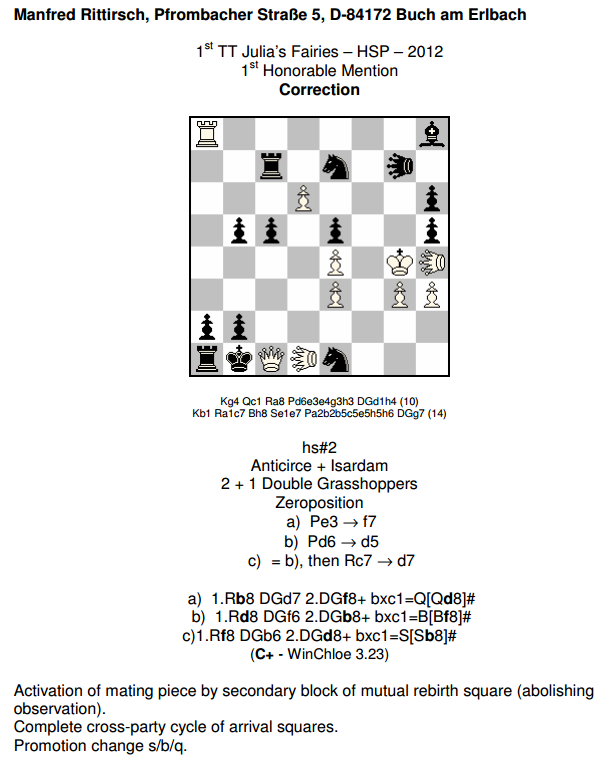
(23-Apr-2013)
2) 2 corrections are made to specifications of solving programs after solutions (28-Apr-2013):
- 1st Honorable Mention – Manfred Rittirsch – “(Py 4.61)” is changed to “(WinChloe 3.21)” – it was my mistake, and I appologize for it!
- Commendation – Pierre Tritten -“(WinChloe)” is changed to “(WinChloe 3.21)”
Director of JF 1st T.T. HSP-2012 – Julia Vysotska.



